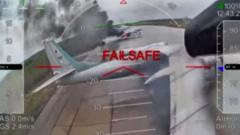The 'Spider Web' operation, a meticulously planned drone strike launched by Ukraine, targeted key military installations in Russia, demonstrating tactical innovation and raising significant implications for the ongoing conflict.
Ukraine's 'Spider Web' Operation: A Showcase of Ingenious Warfare

Ukraine's 'Spider Web' Operation: A Showcase of Ingenious Warfare
An in-depth look at Ukraine's audacious drone attack on Russian airbases, highlighting strategic ingenuity and operational details.
Ukrainian President Volodymyr Zelensky oversaw an operation on June 1, wherein over 100 drones launched an unprecedented offensive against Russian airbases, particularly aimed at nuclear-capable long-range bombers. This complex mission, termed "Spider Web," revealed its expansive scale with explosions reported in multiple Russian regions, including Murmansk and Irkutsk, showcasing the operational breadth achieved by Ukrainian military strategies despite being over 8,000 kilometers from its own borders.
The Russian Defence Ministry acknowledged attacks in five regions but asserted that significant damage was confined to Murmansk and Irkutsk. In contrast, Ukraine claims the drone strikes inflicted substantial losses, asserting that 41 strategic bombers were targeted, with at least 13 reported destroyed. Videos authenticated by the BBC corroborated damage to aircraft in both Murmansk and Irkutsk.
The operation's brilliance lay in the execution. Ukrainian drones were stealthily smuggled into Russia inside wooden structures atop trucks, a method that ensured the drivers were unaware of their cargo. Eyewitness accounts from Russian state media describe how some truck drivers attempted to ward off drones as they launched from the vehicles. Zelensky, who publicly took pride in the operation, disclosed that the project took 18 months to prepare, reflecting Ukraine's lengthy commitment to strategic planning in the conflict.
Technical analyses reveal that while the drones were basic quadcopters, their successful navigation into Russian territory and operation amid fierce defenses demonstrated superior remote pilot capabilities. Aerospace expert Dr. Steve Wright remarked that not only did the drones likely employ GPS technology, they also managed to outwit Russia's jamming efforts, indicating a notable advancement in Ukraine's drone warfare tactics.
The targets of this operation included critical military platforms, reinforcing a strategy focused on projecting power against adversarial air capabilities, especially those used for strikes against civilian areas in Ukraine. The drones disrupted Russia's operational readiness, complicating aircraft repairs and replacements, as such strategic bombers, including Tu-95s and Tu-160s, are no longer in production.
Even as the Russian narrative began diminishing the significance of the attack, state media maintained a silence that suggested concern over the strategic implications of 'Spider Web.' Simultaneously, Ukrainian public sentiment celebrated the operation as a major triumph, with hopes of the successful strike changing dynamics in military engagements moving forward. The incident serves as a pivotal point in the ongoing conflict, showcasing Ukraine's innovative approach to modern warfare and its implications for future engagements.



















